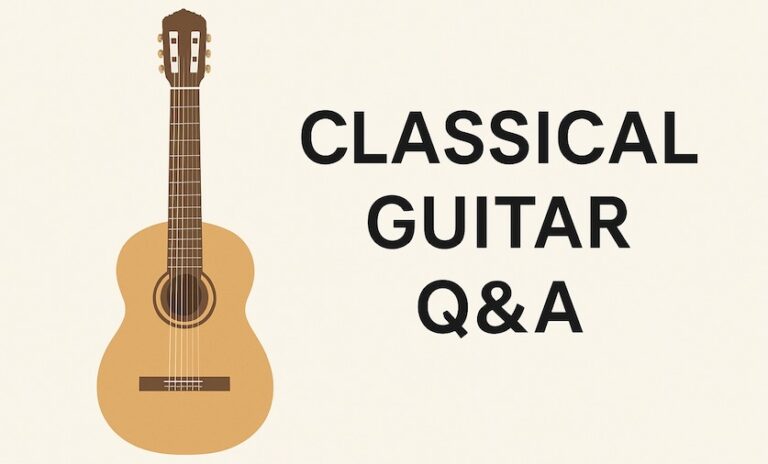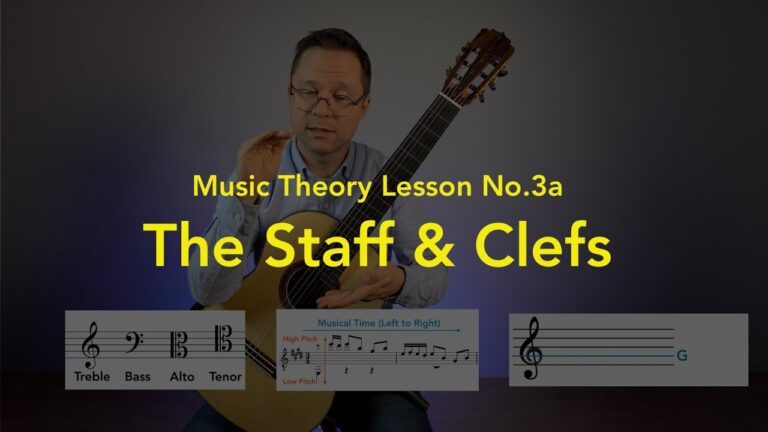Beginner lessons for classical guitar. This page lists a number of beginner and early-intermediate lessons for classical guitar. These tips and tutorials are 100% free so take some time to learn classical guitar properly. Classical guitar is a great instrument to start learning for any age group. The number of styles and musical eras we play are as wide and vast in variety as it gets.
- Also see our main lesson page for all levels.
- Get my free 100 page PDF method book with video lessons.
- Join the email newsletter – It’s free. This is how you’ll receive inspirational classical guitar videos, pro performances, lessons, sheet music, and more.
Quick Questions and Answers
- What guitar should I buy? Check out my guide to beginner guitars here.
- What gear do you recommend? See the gear page for recommendations but you’ll need a footstool.
- Is classical guitar good for beginners? Beginners often find the nylon strings on classical guitars very easy to play and the warm and smooth sound very pleasing. The variety of things you can do on a classical guitar is amazing, from Renaissance music, Latin American, to modern pop. Classical guitar is less good for strumming with a pick, although it still works. If you want that classic folk strumming sound go for a steel string acoustic. Of course, if you want to learn electric guitar you should play electric.
- Is it hard to learn classical guitar? It’s still a guitar with six strings so it’s as easy as any other guitar. One aspect that might slow you down is learning to read music which is considered an important step in learning classical guitar. That said, in the long run you’ll save a ton of time and regrets. I get so many people writing me about how they wish they read music better and had learned it at the beginning as part of their early studies.
- Do I need to play with nails? Not at first. I recommend you play through my first method book and then see my nail article (below).
- What book should I use to learn? I recommend my free pdf method as it comes with free videos lessons for each page. This will help you learn musically and properly. You can always go through another book after to solidify the concepts.
General Beginner Advice
- 10 Classical Guitar Lessons for Beginners – The Above Video
- Tips and Advice for Beginner Classical Guitarists
- Should Beginners Use Rest or Free Stroke?
Essential Lessons – How to sit and hold your hands
- Basic Technique Overview Video – Photos, Tips, & Diagrams (Below)
- Sitting Position for Classical Guitar – Video, Photos, Tips, Diagrams
- Right Hand Position for Classical Guitar – Video, Photos, Tips, Diagrams
- Left Hand Position for Classical Guitar – Video, Photos, Tips, Diagrams
More Lessons for Beginner Classical Guitar
- Ideas to Consider & Revisit Often
- How to Practice Music and Organize Your Practice Session
- How to Play Legato on Classical Guitar
- Fingernail Lesson for Classical Guitar
- Playing Musically
- Right Hand Tone Production
- Slurs on the Guitar
- Alternating Right Hand Fingers
- Right Hand Fingering Lesson Parts 1-4
- Right Hand Planting & Preparation
- 4th Finger Position and Left Hand Alignment
- Left Hand Preparation
- Left hand stretches (beginner to intermediate)
- Vibrato Lesson for Classical Guitar
- Is it ok to collapse the right hand fingertip joint when playing guitar?
- Beginner Technique Routine
- Lessons and Conversations with David Russell
- Avoiding Tension when Playing
My Educational Books for Classical Guitar
- Learn to Play and Read Music – My educational book series, study in the order below.
- Classical Guitar Method Book Vol. 1 – My free PDF method with 20+ video lessons for beginners
- Classical Guitar Method Book Vol. 2 – Continue your progress, 15+ video lessons
- Classical Guitar Technique – Start this along with the below books
- Classical Guitar Repertoire Lessons Grade 1 – Dedicated lessons preparing you for each piece
- Classical Guitar Repertoire Lessons Grade 2
- Classical Guitar Repertoire Lessons Grade 3
- Ten Classical Etudes – Classical era studies with video lessons (Grade 4-7)
More Beginner or Easy Classical Guitar Pieces
- Beginner
- Volume 1 – Method Book Level Pieces & Lessons (Free PDF)
- Exercise on the E String by Mertz (Free PDF)
- Arpèges de Trois Notes by Carulli (Free PDF)
- Lecon 13 by Bosch (Free PDF)
- Preparatory Grade
- Volume 2 – Method Book Level Pieces & Lessons
- Dreams by Richard Summers – Book
- Greensleeves Arrangement Lesson – PDF
- Lesson 46 by Sagreras Lesson – Book
- Robin Reddocke from the Ballet Lute Book – PDF
- Grade 1
- The Spanish Pavin (Anonymous) – My Grade 1 Book (PDF)
- Lección 75 by Julio Sagreras – My Grade 1 Book (PDF)
- Leccion 70 by Julio Sagreras – My Grade 1 Book (PDF)
- Ècossaise Op.33, No.2 by Giuliani – My Grade 1 Book (PDF)
- Lección 19 by Dionisio Aguado – My Grade 1 Book (PDF)
- La Tirantine by Adrian Le Roy – My Grade 1 Book (PDF)
- Exercise No.11 by Napoléon Coste – My Grade 1 Book (PDF)
- Andantino Op. 50, No. 1 by Mauro Giuliani – PDF
- Canson Englesa (Lusty Gallant) [also Bransle Englese] – PDF/Book
- Tanz by Georg Leopold Fuhrman – PDF
- Waltz by Calatayud (Grade 1) -Book
- Waltz, Op. 121, No. 1 by Ferdinando Carulli -PDF
- Andantino by Johann Kaspar Mertz – PDF
- Grade 2
- The Passemeze Pavin – Anonymous – My Grade 2 Book (PDF)
- Andantino in A Minor, Op.59 by Carcassi – My Grade 2 Book (PDF)
- Allegretto in E Minor, Op.59 by Carcassi – My Grade 2 Book (PDF)
- Espanoleta (Theme) by Sanz – My Grade 2 Book (PDF)
- Lantururu by Sanz – My Grade 2 Book (PDF)
- Romanza by Mertz – My Grade 2 Book (PDF)
- Moderato by Mertz – My Grade 2 Book (PDF)
- Andante Op. 35, No. 1 by Fernando Sor – PDF
- The Ash Grove – Llwyn Onn – PDF
- Gigue from Suite in C Major by Johann Anton Logy – PDF
- Moderato by Ferdinando Carulli – PDF
- Oh Shenandoah for Easy Guitar – PDF
- The Skye Boat Song (Outlander Theme) – PDF
- Andante by Johann Kaspar Mertz – PDF
Beginner Practice Tips
1. Reexamine your posture and hand positions – Small adjustments in a number of places in your set up can make a big difference. Beginners need to constantly reevaluate.
2. Consider ergonomics on classical guitar – Beginners and intermediate students should closely watch for strange contortions and anything that is not ergonomic. Using a mirror can help.
3. Practice very slowly – I’ve rarely encountered a student who practices as slowly as I think they should. Practicing ultra slowly will ensure you are playing with your best hand positions, sound, confidence, relaxation, accuracy, and more. Once you can play something well at a slow tempo, you can speed it up while keeping an eye on the quality level.
4. Play the melody on its own (keep it simple) – If you can’t play the melody nicely on its own, how can you play all the note? Learn to play the melody nice and legato first and introduce the rest of the notes after.
5. Dive deeper into musicality – Students can get super caught up in their own technique and progress but remember to strive for better phrasing, dynamic shaping, and overall musicality.
6. Quality practice and happiness – Making your practice sessions enjoyable will be key to long-term musical success and development. When experiencing difficulties, break up the piece or exercise into small manageable goals at a speed you can accomplish successfully. Even if you only play a few notes at a time, playing successfully will improve your skills and give you a feeling of accomplishment.
7. Treat and reward yourself – Make your practice session an enjoyable and special time of your day. Have a treat or nice coffee, buy that nice music stand and metronome.
8. Playing well, don’t compare yourself to others (too much) – Focus instead on having a solid rhythm, legato lines, confident and full tone. Forget about reaching fast tempos, develop a solid and beautiful foundation first.
9. Listen to more music (not just guitar) – You must increase your awareness of the larger musical world. Guitar is great but it’s only a small niche and won’t inform you of all the musical eras diversity. Listen to piano, strings, symphonies, Bach cantatas, voice, lieder, and more.
10. Practice everyday, there are no bad days – I don’t believe in good or bad practice days. All days are good opportunities to practice something. On days when you are having trouble focusing or executing material cleanly, slow down your speed and use a metronome until you are playing well. You may have to play at half the speed you intended but you can still get in some quality practice.




This beginner information is providing me with all the ingredients to make solid progress and experience maximum enjoyment from my newly acquired classical guitar. Going to include reviewing this webpage as part of my daily practice routine until I have fully absorbed all the information. Thanks Bradford.
Glad it helped! Happy practicing!